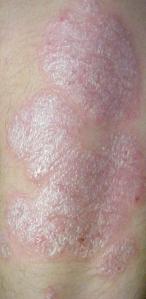Psoriasis
Psoriasis is a condition whose main symptom is gray or silvery flaky patches on the skin which are red and inflamed underneath. In the United States, it affects 2 to 2.6 percent of the population, or between 5.8 and 7.5 million people. more...
Commonly affected areas include the scalp, elbows, knees, arms, stomach and back. Psoriasis is autoimmune in origin, and is not contagious. Around a quarter of people with psoriasis also suffer from psoriatic arthritis, which is similar to rheumatoid arthritis in its effects. Psoriasis was first given that name in complete differentiation from other skin conditions by the Austrian dermatologist Ferdinand von Hebra in 1841, although there are what are believed to be descriptions of the disease in sources going back to ancient Roman and possibly even biblical times.
Types of psoriasis
ICD-10 codes are provided where available.
Plaque psoriasis (L40.0)
Skin lesions are red at the base and covered by silvery scales.
Also known as Classic Psoriasis or Psoriasis Vulgaris. The most common form of psoriasis, affecting about 80% of people with the disease. People with plaque psoriasis have raised, red, inflamed areas of skin—called plaques—often on the scalp, knees, elbows, chest, or back. These inflamed plaques of skin are covered by a silvery-white buildup called scale. It will often reoccur and its cause is not fully understood, although it is generally considered to be an autoimmune disease.
Pustular psoriasis (L40.1)
Blisters of noninfectious pus appear on the skin. Attacks of pustular psoriasis may be triggered by medications, infections, stress, or exposure to certain chemicals.
Guttate psoriasis (L40.4)
Small, teardrop shaped lesions appear on the trunk, limbs, and scalp. Guttate psoriasis is most often triggered by upper respiratory infections (for example, a sore throat caused by streptococcal bacteria).
The second most common form of psoriasis, characterized by small, pink or red drops on the skin. This type of psoriasis may cover a large portion of the body and is usually found on the chest, back, arms, or legs. It appears after a bacterial infection such as strep throat, especially in younger patients. Some cases go away without treatment in a few weeks, while many cases are more persistent and require treatment.
Psoriatic arthritis (L40.5)
Joint and connective tissue inflammation that produces symptoms of arthritis in patients who have or will develop psoriasis.
Inverse psoriasis (or "Flexural psoriasis", L40.83)
Smooth, red patches occur in the folds of the skin near the genitals, under the breasts, or in the armpits. The symptoms may be worsened by friction, sweating and/or the presence of yeast or fungal infections. It is called inverse psoriasis because it occurs in moist areas, areas that aren't normally affected by classic psoriasis.
Read more at Wikipedia.org



